The Redmi K series product line planning is gradually improving. Since last year, it has had four different positionings: medium cup, large cup, super cup, and e-sports version. This year, the Redmi K series has launched three new models, the K50 Gaming Edition, K50, and K50 Pro, and with the release of the Snapdragon 8+, Redmi has also revealed the last trump card of the K50 series, the Redmi K50 Extreme Edition.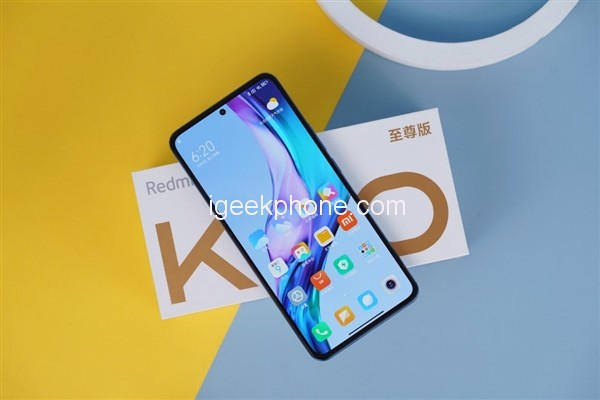
Everyone is familiar with the Snapdragon 8+, and the Redmi K50 Extreme Edition not only releases the Snapdragon 8+ in place, but also has powerful performance, moderate temperature, and a major upgrade in screen display and image.
1. The trade-off between high image quality and low power consumption of the exclusive customized 1.5K supreme screen
1080P resolution has low power consumption, but is not clear enough; 2K resolution has a high resolution, but high power consumption.
When many mobile phones struggle with whether to use a 2K resolution screen, the Redmi K50 Extreme Edition provides a unique solution.
Xiaomi and the supply chain jointly developed a 1.5K screen. The so-called “1.5K” does not refer to resolution alone, but to innovation in the whole link from screen materials, screen structure, and screen technology to mass production ramps.
The Redmi K50 Extreme Edition adopts a new generation of luminescent materials, double-layer circuit design, flagship BSM technology, and a larger aperture ratio. The new diamond-like arrangement allows the screen’s equivalent resolution to reach 0.8, 2712 × 1220 screen resolution, etc. Effective PPI reached 356.
In this way, the Redmi K50 Extreme Edition has found the golden combination of high image quality and low power consumption and achieved a power consumption level almost equivalent to 1080P when the actual look and feel are comparable to that of a 2K screen.
At the same time, this screen also continues the well-received 1920Hz high-frequency PWM dimming of the previous generation, which can not only retain the color accuracy in dark light but also solve the problem of a low-brightness flashing screen. Using mobile phones at night can achieve eye protection. Purpose.
2. The long-lost screen fingerprint returns
The K40 series changed the fingerprint recognition to the side capacitive type. As a result, user acceptance is polarized. Many people think that this solution is very cheap, and products without screen fingerprints have no sense of luxury.
Now, after two years, the screen fingerprint recognition that everyone has been waiting for has finally returned, and it also has many practical functions such as heart rate monitoring and fast payment.
At the same time, this also marks that the Redmi K series products will develop in a higher direction.
3. The first new CMOS and OIS optical image stabilization
The camera of the Redmi K50 Extreme Edition is equipped with a new 108-megapixel Samsung S5KHM6 sensor for the first time and continues to use a 1G+5P glass-plastic hybrid lens, which greatly increases the amount of light entering and effectively improves the glare problem.
In addition, this main camera also adds OIS optical image stabilization, which effectively offsets the shooting shake and improves the filming rate.
4. Snapdragon 8+ supports Redmi’s strongest flagship machine
As Redmi’s strongest flagship mobile phone, the Redmi K50 Extreme Edition will undoubtedly use Qualcomm’s strongest SoC – Snapdragon 8+. Based on TSMC’s 4nm process technology, the theoretical performance of both CPU and GPU will increase by 10%, while power consumption is 30% lower.
Up to 12GB LPDDR5 6400Mbps memory and 512GB UFS 3.1 flash memory, this is also the second Redmi flagship machine with 512GB storage after the Redmi K20 Pro Extreme Edition. The specific parameters of the Redmi K50 Extreme Edition are shown in the following figure:
Design & Display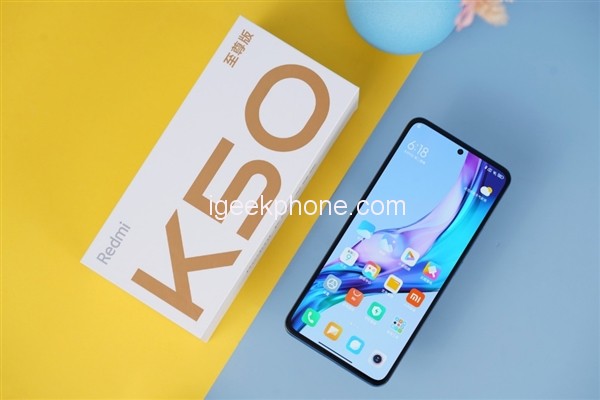
The front of the Redmi K50 Extreme Edition uses a 6.67-inch OLED flexible screen with a resolution of 2712×1220, which reaches an equivalent PPI of 356. In addition, the highest refresh rate and 480Hz touch sampling rate are up to 12bit color depth and 1920Hz high frequency. PWM dimming.
The front-centered single-hole camera uses the same 20-megapixel Sony IMX596 as the Redmi K50 Pro, and the micro-slit earpiece at the top is integrated with the frame. The bottom of the phone adopts a very narrow frame, the chin is controlled in place, and the overall field of vision is wider.
The camera module on the back of the phone adopts a layout similar to the Xiaomi Mi 12 series, with a huge 100-megapixel main camera on the top, an 8-megapixel ultra-wide-angle lens, and a 2-megapixel macro lens on the bottom, and the right side is equipped with dual-color temperature LED compensation. light.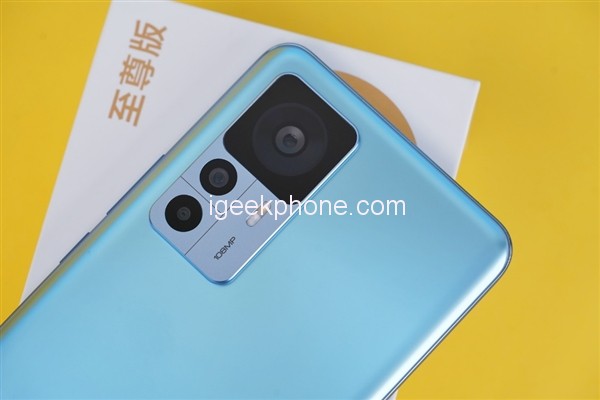
The back body of the Redmi K50 Extreme Edition is made of glass, using AG matte processing technology, and the edge is designed with extreme deep bends, which better fits the palm and feels smooth in the hand.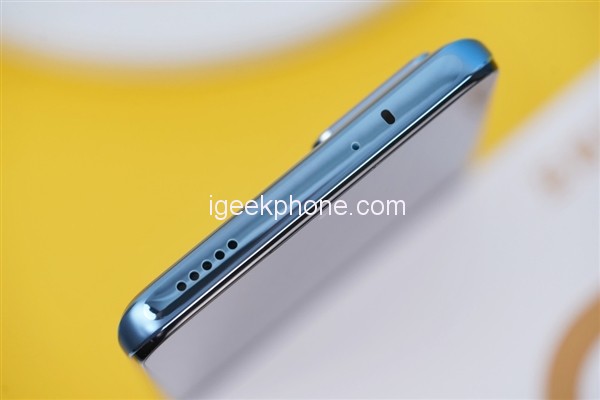
The top openings of the Redmi K50 Extreme Edition are followed by 1012 stereo speakers, noise-canceling microphones, and infrared remote control sensors. The bottom of the phone is equipped with 1216 stereo speakers, which form a dual stereo with speaker openings at the top. On the right side are the microphone, Type-C charging port, and SIM card slot, but there is still no 3.5mm headphone jack.
The Redmi K50 Extreme Edition comes with a charger that supports 120W fast charging. According to the official introduction, the large 5000mAh battery can be charged to 100% in 19 minutes.
Display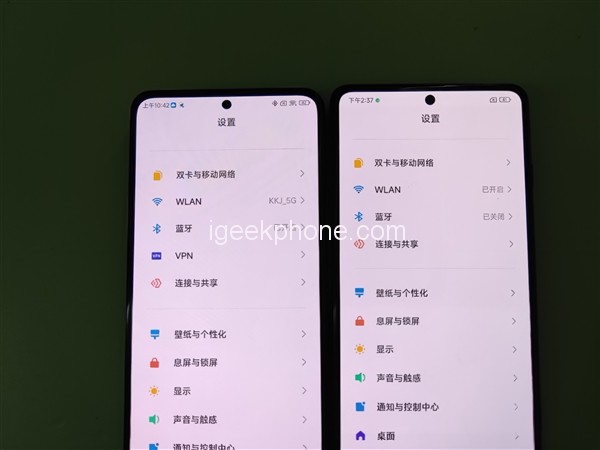
As for why the Redmi K50 Extreme Edition has a 1.5K screen, Xiaomi has given a clear answer. After Redmi’s research, the frequency that users choose to turn on 2K is not high. If the battery capacity is not particularly high, the proportion of choosing the screen resolution to fall back on will be higher. If the sample data is enlarged to a million level, The result will be more obvious.
Therefore, for the 1.5K screen, it is a compromise between battery life and clarity, and it is also a better balance of current screen technology.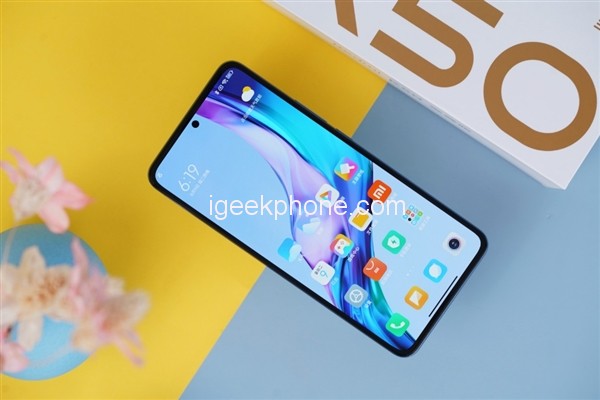
However, some people may think that simply upgrading from standard FHD to FHD+ is not the case. This screen of the Redmi K50 Extreme Edition is a custom screen with a pixel resolution between FHD and 2K, so it is a 1.5K standard.
This custom screen is not a direct procurement solution from the supply chain. Redmi participates in the whole process of screen design, customization, trial production, and mass production ramping. It is a product jointly developed and created by the joint supply chain. It is a new work jointly designed, jointly developed, and mass-produced by Redmi and the screen factory. It is completely customized according to the standard process of developing a new screen. It is by no means a ready-made solution in the supply chain. It is the core technology of Redmi.
By comparison, it can be seen that the pixel aperture ratio of the Redmi K50 Extreme Edition is significantly larger than that of the K50 Gaming Edition, which ensures the efficiency of light passing through, and the brightness of the screen is also more advantageous.
The above left is the Redmi K50 Extreme Edition with a resolution of 2712×1220 and an equivalent PPI of 356, and the right is the Redmi K50 Gaming Edition with a resolution of 2400×1080 and an equivalent PPI of 322.
If you zoom in on the two screens, you can feel that the screen display effect of the Redmi K50 Extreme Edition on the left is stronger than that of the K50 Gaming Edition on the right, and tends to be more 2K resolution. In our daily use, in terms of the presentation of photos and images, Compared with the standard FHD+ screen, the advantages are more obvious.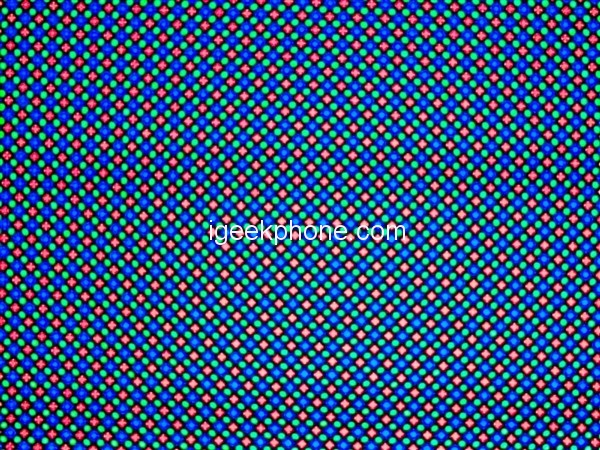
So with a 1.5K screen, can 2K products continue to exist? In this regard, Redmi also said that both are our important product ideas and will be applied to different product lines in the future.
For future product development, the long-term evolution strategy will be continued and deepened on multiple generations of products, including continuous addition of new technical features, and joint efforts with the supply chain to promote the popularization and application of domestic OLED screens, and even promote the innovation and development of independent technologies. progress.
Therefore, the 1.5K extreme screen on the Redmi K50 Extreme Edition interprets Redmi’s philosophy: not only to be a leader in technology but also to achieve the ultimate in experience.
Hardware
The Snapdragon 8+ mobile platform manufactured by TSMC is composed of eight cores: 1×3.19GHz Cortex-X2 large core + 3×2.75GHz Cortex-A710 and 4×2.0GHz Cortex-A510. The GPU adopts Adreno 730, and the main frequency is increased. Up to 800MHz, according to the official introduction, the performance of CPU and GPU is improved by 10%.
Next, we will conduct a running test to see if it conforms to the official publicity.
1. AnTuTu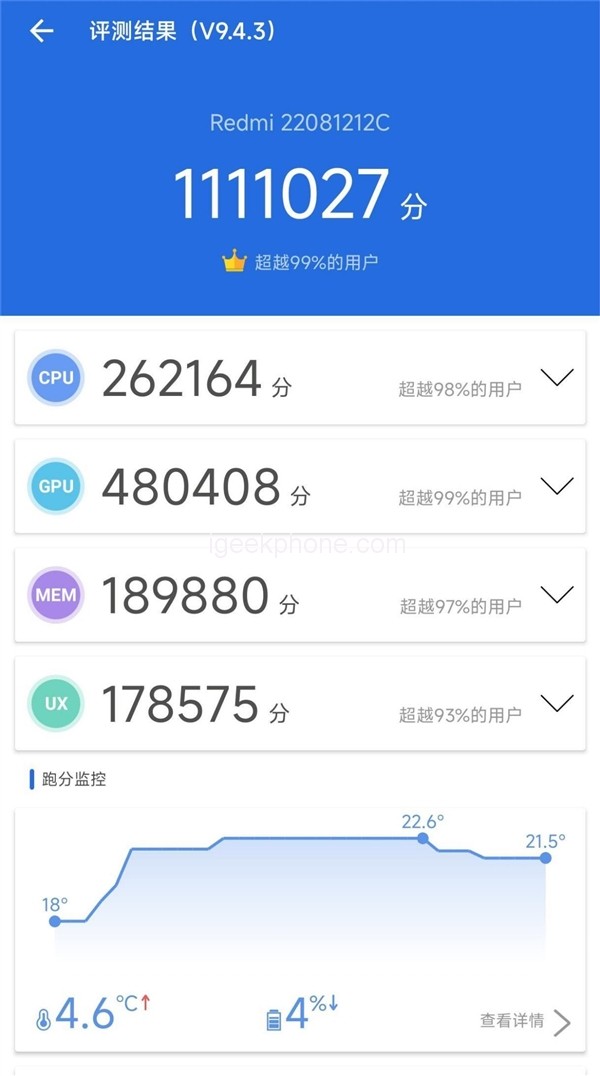
After the comprehensive test of AnTuTu, the total score reached 1,111,027 points, of which the CPU score was 262,164, the GPU score was 180,408, the memory score was 189,880, and the UX score was 178,575. Compared with the Snapdragon 8 of the Redmi K50 e-sports version, the comprehensive ability has increased by nearly 8%.
2. Master Lu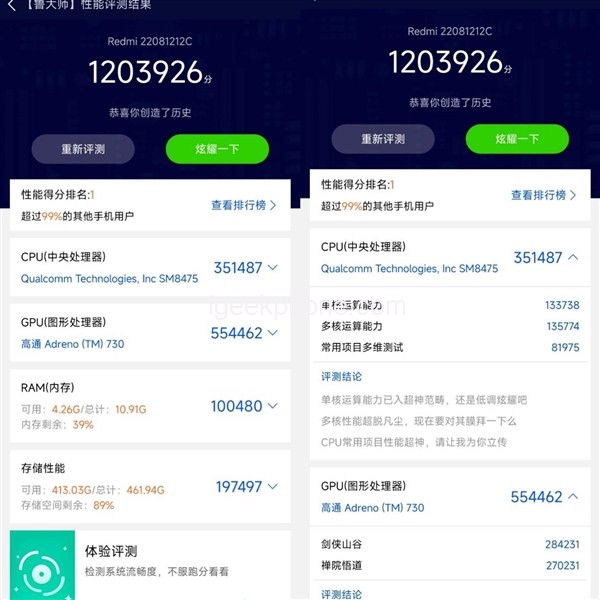
After the comprehensive test of Master Lu, the total score reached 1,203,926, of which the comprehensive score of the CPU was 351,487, the single-core score was 133,738, the multi-core score was 135,774, the multi-dimensional test score of common items was 81,975, and the GPU part of the comprehensive score reached 554,462.
Compared with the previous generation of Snapdragon 8, Master Lu’s comprehensive score has increased by nearly 11%.
3. GeekBench 5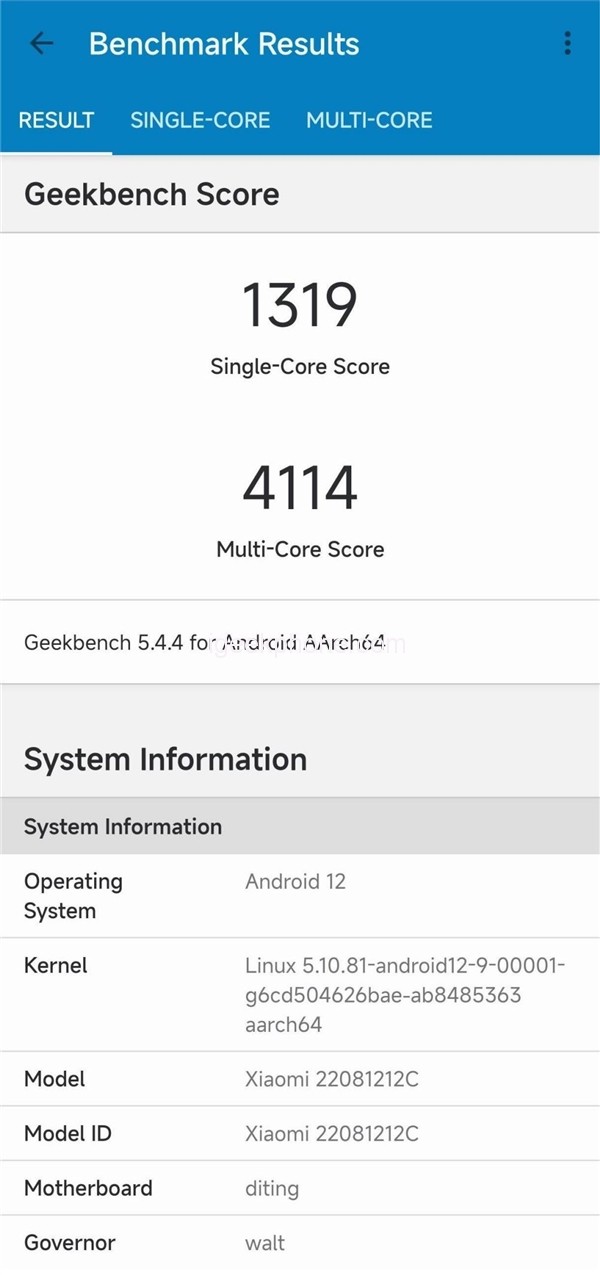
We tested the CPU using GeekBench5. The single-core score of the Redmi K50 Extreme Edition was 1319 and the multi-core score was 4114. Compared with the Snapdragon 8 of the Redmi K50 e-sports version, the improvement is very obvious, of which the single-core increase is 10%, and the multi-core increase is nearly 13%. Said to be in line with the official promotion of 10% of the upgrade.
4. GFXBench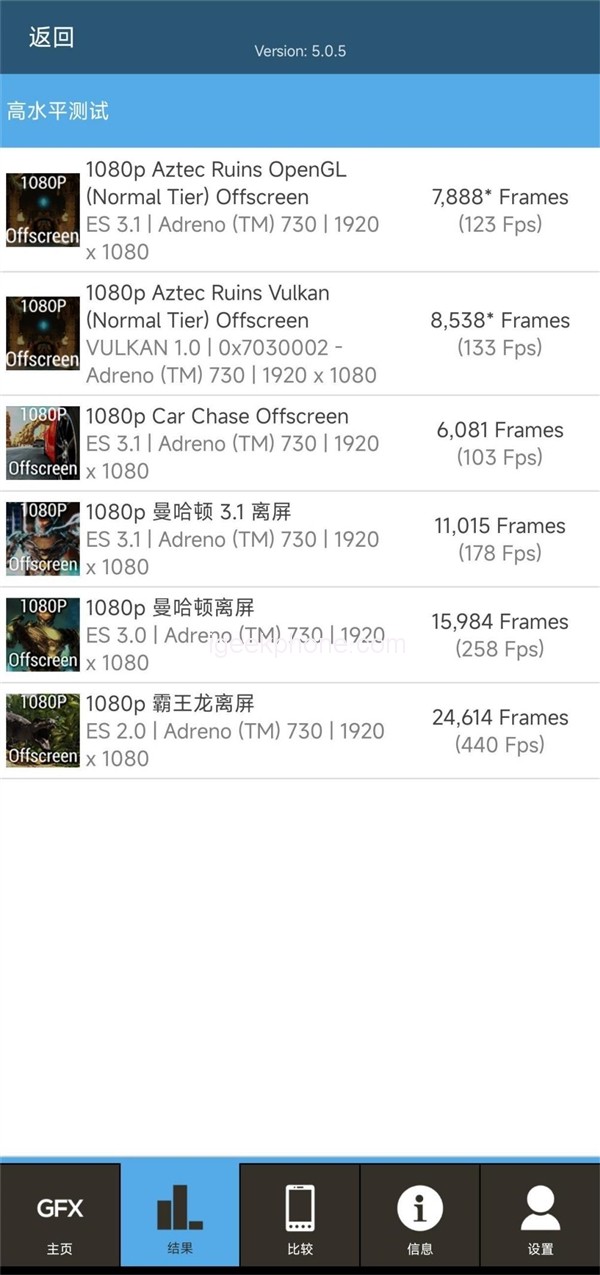
We chose the six 1080P tests on the regular GFXbench for GPU. The first three items of Aztec Ruin OpenGL, Aztec Ruin Vulkan, and Racing Chase ran out of 123FPS, 133FPS, and 103FPS respectively, which were higher than the Redmi K50 e-sports version. 9.3%, 8.9%, 8.8%.
After the first three rounds of tests, the temperature of the mobile phone gradually increased, and the test results of the last three items can reflect the performance of the mobile phone in high-rendering 3D games. Manhattan 3.1, Manhattan, and Tyrannosaurus Rex ran out of 178FPS, 258FPS, and 440FPS respectively. , compared with the Snapdragon 8, the improvement is about 5%.
5. Adrobench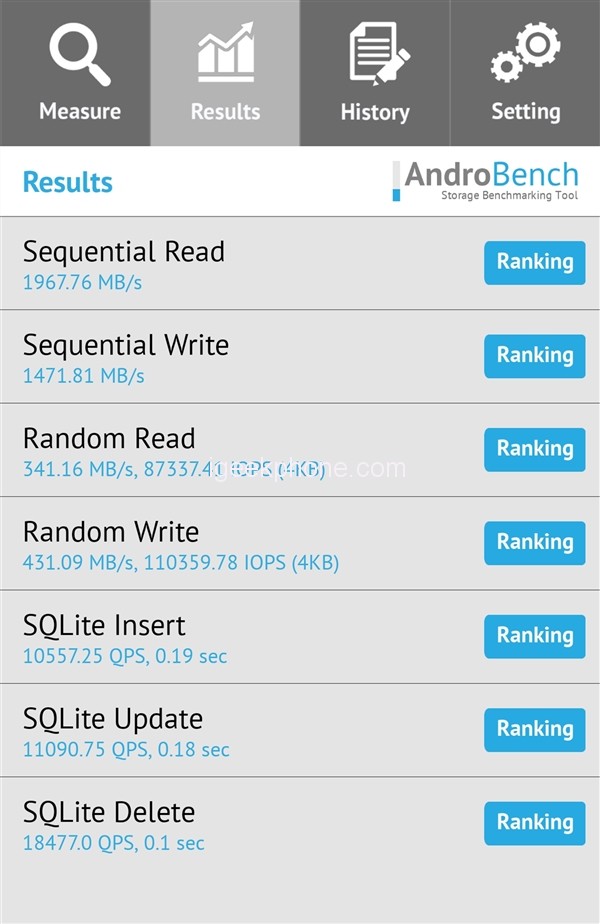
We use Adrobench for storage testing, the Redmi K50 Extreme Edition has a sequential read rate of 1967.76MB/s, a sequential write rate of 1471.81MB/s, a random read rate of 341.16MB/s, and a random write rate of 431.09MB/s, at the flagship level.
5. Game test: The frame rate of the mobile game “Genshin Impact” is stable and the temperature control performance is acceptable
For the game test, we selected three mainstream mobile games, “Honor of Kings”, “Peace Elite” and “Genshin Impact”, and tested them in an office environment with a room temperature of 28°C.
1. Glory of the King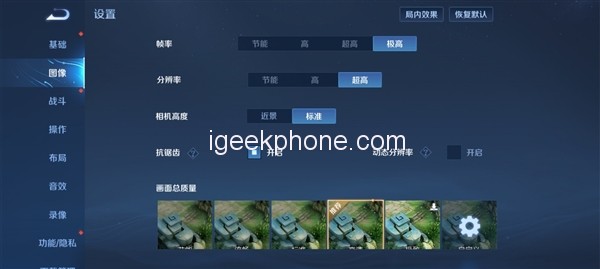
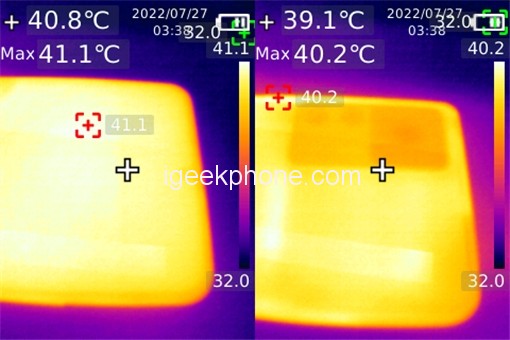
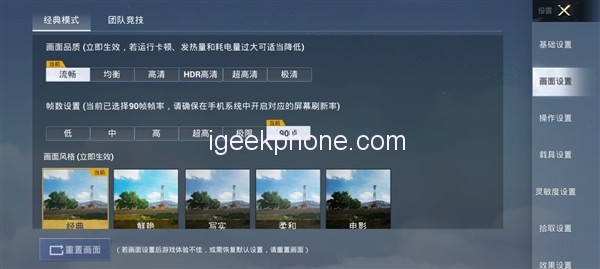
In the “Honor of Kings” mobile game, we played the Redmi K50 Extreme Edition for nearly 15 minutes when the highest image quality + 120 frame rate was turned on, and the frame rate was almost as stable as a straight line, with almost no fluctuations, and the average frame rate was 119FPS.
The Snapdragon 8+ can give full play to its performance when dealing with low-load games to ensure the stability of the game.
In terms of temperature performance, the highest temperature on the front of the fuselage is 41.1 degrees Celsius, and the highest temperature on the back of the fuselage is 40.2 degrees Celsius. It is warm in the hand during the game, and the fuselage does not feel obvious heat.
2. Peace Elite

The “Peace Elite” mobile game can open the smooth screen + 90 frame mode in the Redmi K50 Extreme Edition, and we give priority to the highest frame rate.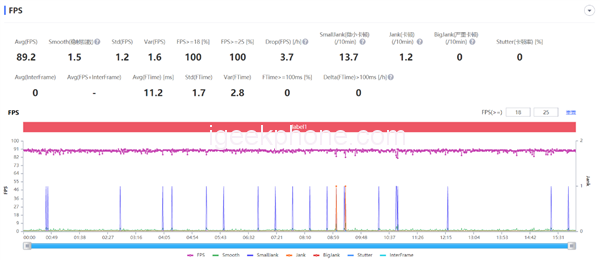
After nearly 15 minutes of testing, the average frame rate of the game is stable at 89.2FPS. It can be seen that the frame rate tends to be a straight line, and the whole game is very stable.
In terms of temperature, the highest temperature on the front of the fuselage is 43.3 degrees Celsius, and the highest temperature on the back of the fuselage is 42.2 degrees Celsius, which is a little hot, but not too hot.
3. Yuanshen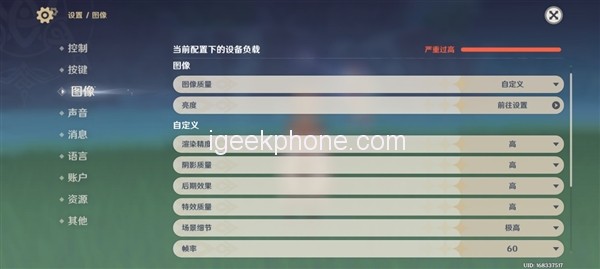
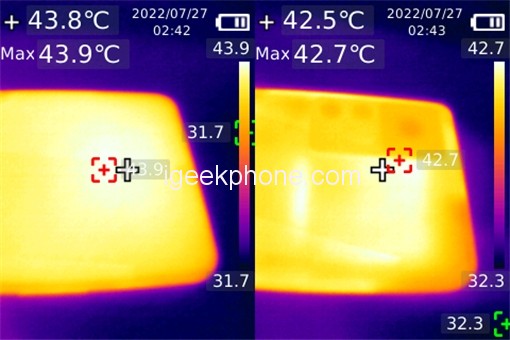
After testing, the “Genshin Impact” mobile game has been tested for 10 minutes with the highest image quality + 60 frame mode turned on, and the overall fluctuation is slightly, but it is not too big, and the average frame rate can be maintained at 58.1FPS. It’s quite an excellent result.
Next, look at the temperature performance. The highest temperature on the front is 43.9 degrees Celsius, and the highest temperature on the back is 42.7 degrees Celsius.
When we hold the phone, the back of the phone is in contact with the skin, and we will not feel any obvious heat, not to mention that this is a test conducted in an indoor environment of 28 degrees Celsius in summer. The Snapdragon 8+ can have such a calorific value, which is completely acceptable.
Cameras
The Redmi K50 Extreme Edition rear main camera is equipped with a 108-megapixel Samsung S5KHM6 sensor, with a 1/1.67-inch photosensitive unit, equipped with a more advanced 9-in-1 Nonapixel Plus technology, with 1.92μm large pixel output, reducing dark light noise, At the same time, the 1G+5P glass-plastic hybrid lens can greatly increase the amount of light entering, so the night scene performance of the Redmi K50 Extreme Edition makes us look forward to it.
The ultra-wide-angle uses an 8-megapixel Samsung S5K4H7, a 1/4-inch photosensitive unit, and a 1.12μm single pixel.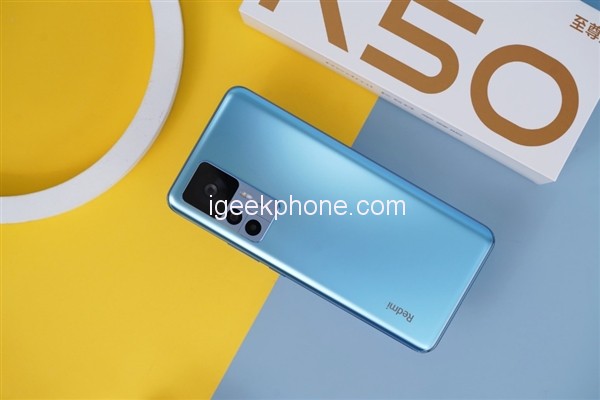
In addition, the Redmi K50 Extreme Edition is equipped with an independent 2-megapixel macro lens, using the GC02M1 sensor, with a 1/5″ inch photosensitive unit and a 1.75µm single pixel.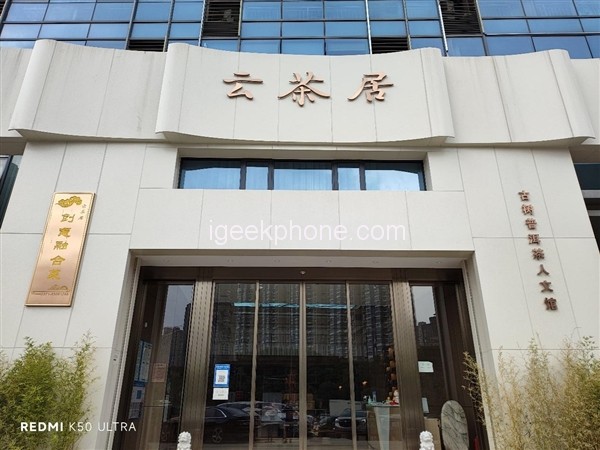
The above are the photos taken by the main camera of the Redmi K50 Extreme Edition in the daytime scene. It has been rainy recently, but with this HM6 sensor with more than 100 Megapixels, thanks to the large pixel output of 1.92μm, the picture presented is not gloomy, and the brightness and color are more pleasing to the eye.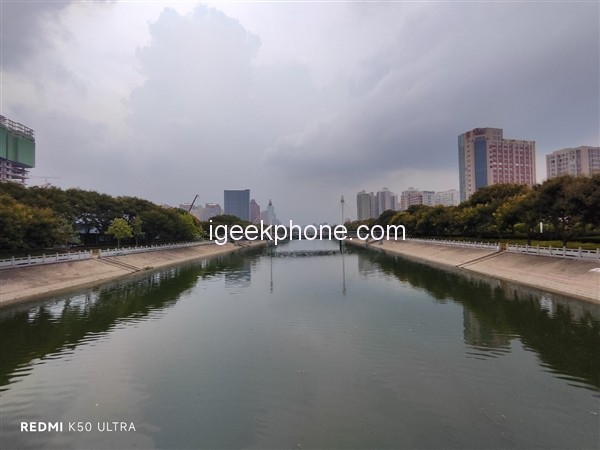 In terms of night scenes, turning on the night scene mode increases the exposure time, and OIS optical image stabilization is also particularly important, which ensures the stability of the picture during long exposures, offsets shooting jitter, and greatly improves the camera’s filming rate. The 1G+5P glass-plastic hybrid lens also exerts its advantages. There is not too much noise in the dark part of the picture, and the purity of the night scene and the reproduction of colors are very accurate.
In terms of night scenes, turning on the night scene mode increases the exposure time, and OIS optical image stabilization is also particularly important, which ensures the stability of the picture during long exposures, offsets shooting jitter, and greatly improves the camera’s filming rate. The 1G+5P glass-plastic hybrid lens also exerts its advantages. There is not too much noise in the dark part of the picture, and the purity of the night scene and the reproduction of colors are very accurate.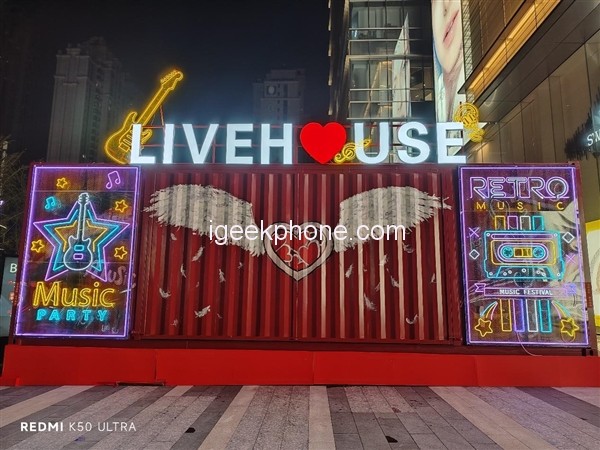
Although the ultra-wide-angle part is only 8 Megapixels, the color and brightness of daily photos are acceptable. The images during the day are relatively pure, and the pictures taken at night have no color cast.
The only shortcoming is that the pixel is low. As long as we do not zoom in to see the details, the overall performance can still fully meet our daily shooting needs for wide-angle images.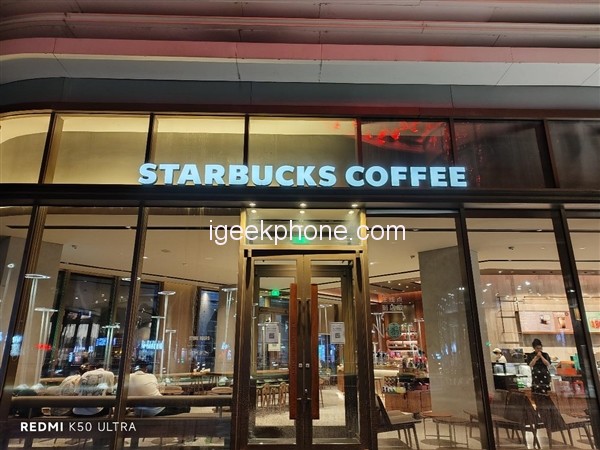
The 2-megapixel macro lens plays a certain role in shooting the texture of close-up objects and small fonts.
Battery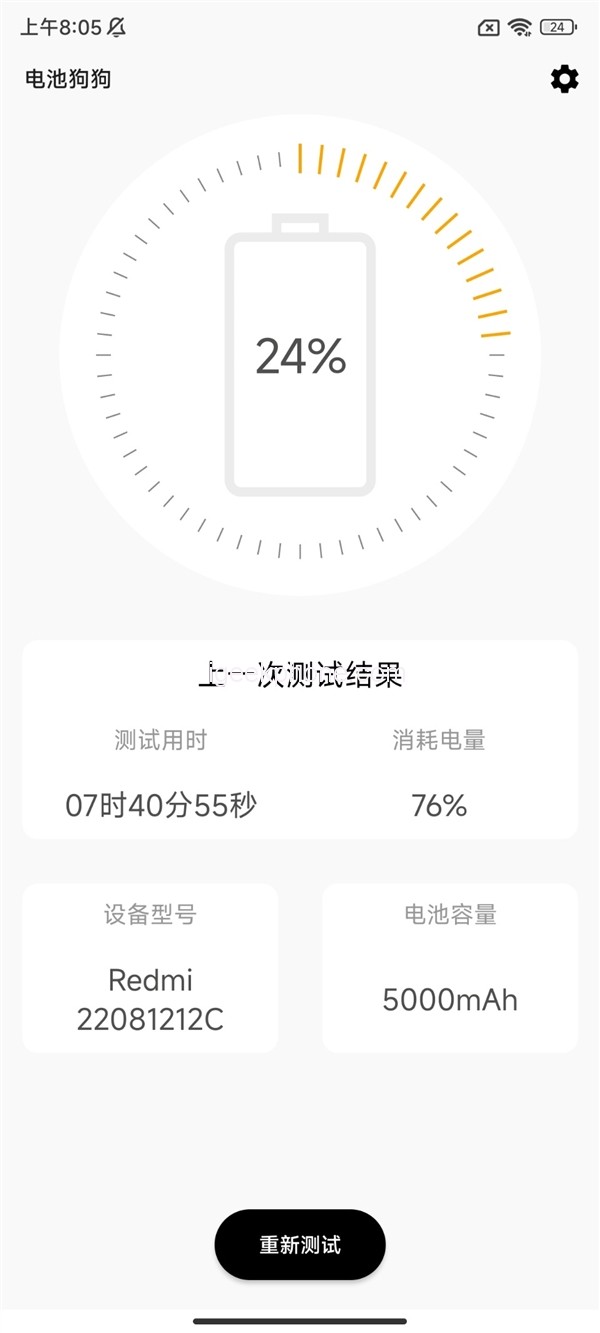
The Redmi K50 Premium Edition is equipped with a single-cell 5000mAh battery, supports up to 120W wired fast charging, and has two built-in Xiaomi self-developed Surging P1 charging chips. In theory, the increase in charging speed will be very obvious.
Charging test
After testing, the Redmi K50 Premium Edition starts from 5%, 5 minutes to 42%, 10 minutes to 57%, 15 minutes to 68%, and 20 minutes to 85%, and it only takes 26 minutes to fully charge.
Battery life test
For the battery life test, we use the professional battery life test tool – the battery dog produced by Kuai Technology.
For the test items, we chose the limit battery endurance test, and checked all the test items including CPU high voltage, CPU multi-threading, AI recognition, picture browsing, video playback, and web browsing, simulating user usage scenarios and restoring the real load to the greatest extent. Infinitely close to the real power consumption.
We manually set the screen brightness of the Redmi K50 Extreme Edition to 50%, turned on the 120Hz refresh rate, and measured the power from 100% to 24%. It took 7 hours, 40 minutes, and 55 seconds in total.
According to the power consumption speed, the comprehensive battery life of the Redmi K50 Extreme Edition is about 10 hours.
This test result shows that the power consumption of the Snapdragon 8+ has been significantly improved. Compared with the Snapdragon 8 of the previous generation Redmi K50 e-sports version, the battery life is nearly 1 hour longer.
Read Also: Nubia Z40S Pro Review: Snapdragon 8+ With 35MM Prime Lens
Verdict
As the strongest model in the Redmi brand so far, the Redmi K50 Extreme Edition has been fully upgraded in terms of screen, image, performance, etc., and the screen fingerprint recognition gives people a feeling of returning to the original intention.
1. Define the future of the 1.5K supreme screen
The Redmi K50 Extreme Edition has exclusively customized a 1.5K extreme screen with an equivalent resolution of 0.8, using two diamond-like arrangements of Huaxing Pearl 2.0 and Tianma Windmill.
Compared with the micro-drill arrangement of the previous generation of Redmi K50 e-sports version of Huaxing Optoelectronics, the pixel density is more compact, which has reached the level of Samsung’s diamond arrangement.
In terms of look and feel, compared with the Redmi K50 e-sports version, the screen clarity of the Redmi K50 Extreme Edition is much clearer at first glance.
2. The screen fingerprints return and the recognition rate is improved again
The light-sensitive screen fingerprint recognition on the Redmi K50 Extreme Edition adopts the same fingerprint recognition module as the Xiaomi Mi 12 series. In terms of experience, compared with the previous generation of mobile phones with screen fingerprints, the Redmi K30 series, after two years, its recognition accuracy has improved. The improvement in recognition speed is very obvious.
At the same time, it also brings many useful functions such as heart rate monitoring, fast payment, and dark light unlocking.
3. The first Samsung HM6 sensor
The 108-megapixel sensor of the Samsung S5KHM6, which was launched in the Redmi K50 Extreme Edition, is more accurate in color reproduction of the proofs shot in cloudy scenes during the day. In terms of night scenes, due to the addition of optical image stabilization, the performance is stronger than that of the Redmi K50 e-sports version.
The 8-megapixel ultra-wide-angle lens is also in place for color reproduction during the day and at night, and there is no obvious distortion at the edges. The 2-megapixel macro lens is very friendly for shooting close-up objects.
In general, the Redmi K50 Extreme Edition has no problem meeting the needs of daily photography in terms of images.
4. The frame temperature of the Snapdragon 8+ flagship core is not high
The Snapdragon 8+ chip on the Redmi K50 Extreme Edition has passed our tests. The frame rate is stable in the games of “Honor of Kings” and “Peace Elite” with medium and low loads, with almost no fluctuation, and the average temperature is around 41 degrees.
For the high-load game “Genshin Impact”, the frame rate fluctuation is slightly obvious, but the average frame rate is maintained at 58.1FPS. Overall, the results are not bad, and the maximum temperature is controlled at 43.9 degrees Celsius, which is mainly concentrated on the front. Feels visibly hot.
All in all, the original 1.5K screen of the Redmi K50 Extreme Edition shows Redmi’s pursuit of hardware exploration and opens up new ideas. The much-anticipated screen fingerprint makes people see Redmi’s sincerity towards fans. In terms of imaging, the first new CMOS + OIS optical image stabilization is at the top level in the Redmi series, and the blessing of Snapdragon 8+ makes the game performance of the Redmi K50 Extreme Edition more in place.
Whether you are a gaming party or a photo enthusiast, especially if you are particularly concerned about the screen, the Redmi K50 Extreme Edition will be a flagship phone not to be missed.
Do not forget to follow us on our Facebook group and page to keep you always aware of the latest advances, News, Updates, review, and giveaway on smartphones, tablets, gadgets, and more from the technology world of the future.










